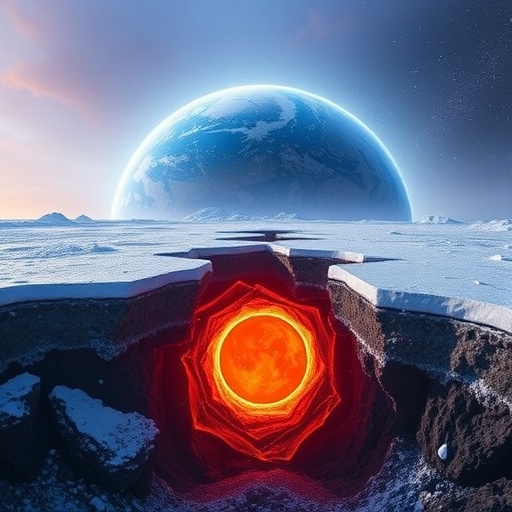A groundbreaking investigation by eminent researchers from the University of Oxford, University of Leeds, and University College London has emerged, shedding unprecedented light on the enigmatic chemistry and crystallization history of Earth’s core. Published in Nature Communications on September 4, 2025, this study elucidates the critical role that carbon may play in the nucleation and gradual solidification of the Earth’s inner core, challenging longstanding assumptions about its composition and the processes influencing the planet’s magnetic shield.
Earth’s core, a fiercely complex environment comprised predominantly of iron, is traditionally divided into a molten outer core and a solid inner core. This inner core grows imperceptibly as the outer core cools and begins to freeze. Yet, the exact mechanisms behind the onset of this solidification have remained elusive, primarily because they depend intricately on the core’s precise chemical makeup. Previous consensus suggested that vast degrees of supercooling—ranging from 800 to 1,000 degrees Celsius below iron’s melting point—would be needed for crystallization to initiate, assuming a core mainly composed of pure iron. Such extreme supercooling would, however, contradict geological and geophysical evidence, which indicates a far more restrained degree of cooling and a well-preserved geomagnetic field throughout Earth’s history.
Addressing this conundrum, the research team utilized state-of-the-art atomic-scale computer simulations involving approximately 100,000 atoms under pressures and temperatures mirroring those deep within Earth’s inner core. These simulations aimed to capture the nucleation process—the early stages where tiny atom clusters begin to form solid crystals within a supercooled liquid metal. By introducing elements believed to reside in the core—such as silicon, sulfur, oxygen, and notably carbon—scientists sought to discover which chemical combinations could realistically permit inner core crystallization with minimal supercooling.
Strikingly, the simulations overturned prior assumptions about silicon and sulfur, showing these elements actually retard the freezing process. Their presence would necessitate even deeper supercooling than previously thought, a scenario incompatible with Earth’s sustained magnetic field and inner core dimensions. Contrarily, carbon demonstrated a potent effect in accelerating crystallization, significantly reducing the supercooling depth required for nucleation to commence. The research posits that even a modest carbon concentration as low as 3.8% by mass in the core could allow freezing at a supercooling threshold of roughly 266 degrees Celsius—far less than earlier estimates for pure iron.
This finding not only supports a carbon-rich Earth core model but also elegantly aligns with seismic data indicating the core’s density deficit relative to pure iron. Carbon’s contribution thus emerges as a linchpin, reconciling geophysical observations and theoretical models. It also suggests that the inner core’s formation was contingent on the presence of carbon, and without it, our planet might lack the protective geomagnetic shield vital for sustaining life on its surface.
Beyond composition, the study offers profound insights into nucleation mechanics under extreme conditions. Unlike the formation of hailstones in Earth’s atmosphere, which initiate around foreign nucleation sites, the researchers demonstrate that inner core nucleation transpired without these “seeds.” Given that potential nucleation facilitators dissolve or melt under core conditions, the team’s simulations provide compelling evidence for homogeneous nucleation within the molten core metal, a process markedly more delicate and dependent on the right elemental mixture.
Co-author Associate Professor Andrew Walker of the University of Oxford illuminated the implications of this discovery: “Our results reveal that the nuanced chemistry of Earth’s core plays a defining role in the behavior and stability of the inner core. Carbon, often overlooked, may be the key element orchestrating the delicate dance of freezing and growth that generates Earth’s magnetic field.”
Lead author Dr. Alfred Wilson of the University of Leeds further reflected on the broader impact, stating, “By probing processes on an atomic scale under conditions impossible to replicate directly, we unlock a window into Earth’s deepest realms. These insights don’t just recount our planet’s ancient history; they enrich our understanding of its ongoing evolution and magnetic dynamism.”
For decades, the age and origin of Earth’s inner core have been subject to debate, with proponents for both a billion-year-old formation and a comparatively young core emerging. This research propels the debate forward by providing a new chemical constraint that could help refine models of Earth’s thermal evolution and core crystallization timelines, enhancing our grasp of planetary dynamics.
The revelation that carbon influences core crystallization also prompts a reevaluation of the Earth’s formation narrative, implicating carbon-rich material accretion during the planet’s early history. This could have broader repercussions for understanding planetary differentiation in terrestrial bodies beyond our own.
Ultimately, this study synthesizes geochemical, geophysical, and computational lines of inquiry into a coherent framework, emphasizing the pivotal influence of carbon within Earth’s interior. This fresh perspective not only advances fundamental Earth science but also highlights the importance of multidisciplinary research in resolving some of the most profound mysteries beneath our feet.
Subject of Research: Chemistry and nucleation process of Earth’s inner core crystallization
Article Title: Constraining Earth’s core composition from inner core nucleation
News Publication Date: 4 September 2025
Web References: https://doi.org/10.1038/s41467-025-62841-4
Image Credits: Dr Alfred Wilson
Keywords
Earth’s core, inner core crystallization, carbon abundance, supercooling, nucleation, geodynamo, magnetic field, atomic simulations, core composition, Earth’s evolution




